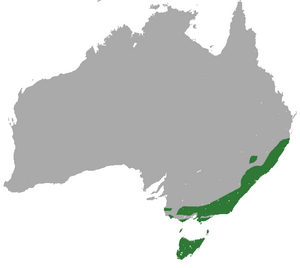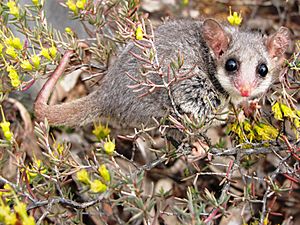Eastern pygmy possum facts for kids
Quick facts for kids Eastern pygmy possumTemporal range: Late Pleistocene - Recent
|
|
|---|---|
 |
|
| Conservation status | |
| Scientific classification | |
 |
|
| Eastern pygmy possum range |
The eastern pygmy possum (Cercartetus nanus) is a tiny marsupial that lives in south-eastern Australia. You can find these small creatures from southern Queensland all the way to eastern South Australia, and even on Tasmania. They live in many different places, like rainforests, woodlands, and heathlands.
Contents
About the Eastern Pygmy Possum
The eastern pygmy possum belongs to a group of animals called Cercartetus. Its scientific name, Cercartetus nanus, means 'dwarf' in Latin, which perfectly describes its small size! A scientist named Anselme Gaëtan Desmarest first described this animal in 1818.
People have called this possum by many names over the years. Some old names include dwarf phalanger, pigmy opossum, and dormouse possum. Eventually, a group called the Australian Mammal Society decided on the standard name: eastern pygmy possum.
What Do They Look Like?

Eastern pygmy possums are very small. They usually weigh between 15 and 43 grams, which is about the same as a few coins. Their body is only 7 to 9 centimeters long, and their tail adds another 8 to 11 centimeters.
They have dull grey fur on their backs and white fur underneath. They have big, almost hairless ears that point forward. Their long prehensile tail can grip things, helping them climb. The tail is thick with fur at the base, but it gets thinner towards the end. They also have long whiskers and a dark ring of fur around each eye.
Life and Habits
Eastern pygmy possums are excellent climbers. They use their special brush-tipped tongues to drink nectar and collect pollen from flowers. They especially love flowers from Banksia, Eucalyptus, and Callistemon trees. When flowers are not available, they also eat insects and soft fruits.
These possums are mostly active at night. Even though they are often thought to be solitary, they have been seen sharing nests. Sometimes, groups of two or more adults live together. During winter, they can go into a deep sleep called torpor to save energy.
Where They Live
Eastern pygmy possums live along the southeastern coast of Australia. You can find them from eastern South Australia to southern Queensland, and also on Tasmania. They prefer places with lots of shrubs and bushes.
They live in many different environments, from open heathlands to thick rainforests. They can be found from sea level up to 1800 meters high in the mountains. Even though they live in many places, they are not found everywhere. Their populations are often small and spread out.
Baby Possums
Eastern pygmy possums usually have babies twice a year. If there is plenty of food, they might even have a third litter. Female possums have a special pouch with four to six teats, where their babies develop.
They usually give birth to four young, but sometimes they have more. The babies stay in their mother's pouch for about 33 to 37 days. They are weaned (stop drinking milk) when they are about 60 to 65 days old. After that, they stay with their mother for at least ten more days.
Young possums reach their full adult size around five months old. They can start having their own babies as early as three months after birth. In zoos, they can live up to 7.5 years, but in the wild, they probably live for about five years.
How They Were Discovered
The first eastern pygmy possum known to Europeans was found by François Péron. He was a naturalist on a trip with Nicolas Baudin in 1802. While visiting Maria Island off Tasmania, Péron traded with the Aboriginal people. He got a small marsupial that was about the size of a mouse.
Péron wrote that he believed it was a new species. This specimen, a young male, was taken back to France. It is now kept in the Muséum National d’Historie Naturelle in Paris. It is a very important specimen for understanding the species.
Ancient Possum Bones
Scientists often find bones of eastern pygmy possums in fossils or sub-fossils. These are found in caves in south-eastern Australia. These bones come from the late Pleistocene and Holocene periods, which were many thousands of years ago.
How did they get there? Owls and quolls (another type of marsupial) would eat these possums. Then, they would leave behind pellets or droppings in caves. These caves were excellent places for the bones to be preserved over time. About 50 such sites have helped us learn about ancient eastern pygmy possums.
Conservation Status
The IUCN lists eastern pygmy possums as "Least Concern". This means they are not currently in danger of disappearing. Both types of eastern pygmy possums (the Tasmanian and mainland ones) are considered low risk by the Australian government.
However, their status can be different in various Australian states. For example, in New South Wales, they are considered "vulnerable." In South Australia, they are also seen as "vulnerable." In Victoria and Tasmania, they are generally not considered threatened. In Queensland, they are often listed as "common," but scientists still need more information.
Who Eats Them?
Many animals hunt eastern pygmy possums. Some of their known predators include different types of owls, like the barn owl and masked owl. Other predators are native animals like the brown antechinus, tiger quoll, and Tasmanian devil.
Sadly, introduced animals like dingos, dogs, red foxes, and cats also hunt them. Even some snakes, like Stephen's banded snake and the rough-scaled snake, will prey on them. Studies have shown that these small possums are quite vulnerable to predators, especially if new predators arrive in their habitat.
Tiny Hitchhikers
Eastern pygmy possums can also have tiny creatures living on or inside them, called parasites. These include different types of fleas and mites. They can also have small worms called nematodes and a common marsupial tick called Ixodes tasmani. Sometimes, a flatworm called Geoplana sp. has been found, but this might have been by accident.
See also
 In Spanish: Pósum pigmeo oriental para niños
In Spanish: Pósum pigmeo oriental para niños


